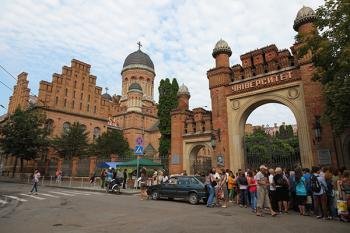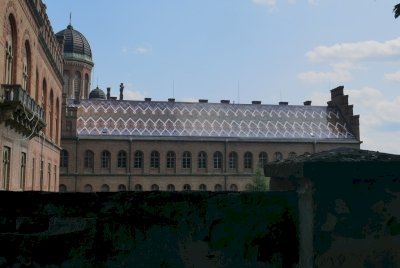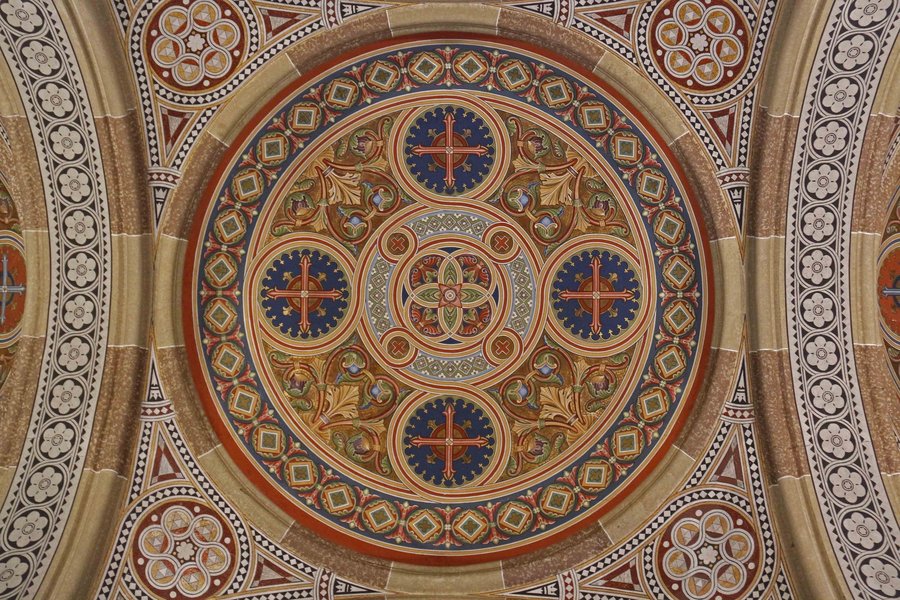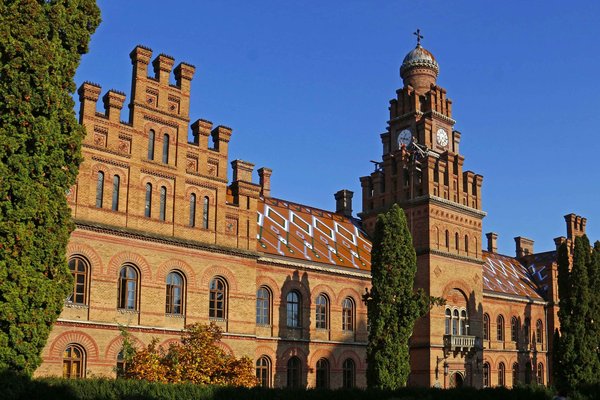Ukraine
Residence of Bukovinian & Dalmatian Metropolitans
The Residence of Bukovinian and Dalmatian Metropolitans is a 19th-century example of historicist architecture.
The complex was the seat of the (arch)bishopry of the Bukovinian Orthodox Church, which developed while this region was under Austrian Habsburg rule and lasted til 1940. In addition to Gothic and Baroque architecture, Byzantine forms were used, mixed with decorative patterns in the local folk tradition. It now is in use as a University.
Community Perspective: The complex lies on the outskirts of the charming historic town of Chernivtsi, close to the Romanian border. The interior of the buildings can only be seen on an organized tour (in Ukrainian), which seems to be conducted on a regular basis.
Site Info
Official Information
- Full Name
- The Residence of Bukovinian and Dalmatian Metropolitans (ID: 1330)
- Country
- Ukraine
- Status
-
Inscribed 2011
Site history
History of Residence of Bukovinian & Dalmatian Metropolitans
- 2011: Inscribed
- Inscribed
- 2010: Incomplete - not examined
- Type
- Cultural
- Criteria
- ii
- iii
- iv
Links
- UNESCO
- whc.unesco.org
- Official
-
- chnu.edu.ua — Chernivtsi National University
All Links
UNESCO.org
- whc.unesco.org — whc.unesco.org/
Official Website
- chnu.edu.ua — Chernivtsi National University
News Article
- April 26, 2012 day.kiev.ua — Residence of the metropolitans is looking for money
Community Information
- Community Category
- Religious structure: Christian
Travel Information
Red Zone Travel Advisory
Recent Connections
-
Red Zone Travel Advisory
Ukraine fully off-limits -
Depicted in Mizielinska Maps
Chernivtsi UniversitySee i.pinimg.com
-
Architectural design competitions
"In 1860, the Religious Affairs Ministr…
Connections of Residence of Bukovinian & Dalmatian Metropolitans
- Trivia
-
-
Dubbed as another WHS
Bukovinian Alhambra -
Modelled after
The Residence complex is said to have been modelled on the layout of the Holy City, Jerusalem in a schematic but symbolic way (AB ev) -
Depicted in Mizielinska Maps
Chernivtsi UniversitySee i.pinimg.com
-
- History
-
-
Habsburgs (Austrian)
Built while under Habsburg rule
-
- Architecture
-
-
Glazed tiles
ornately patterned, glazed tile roofs (AB ev) -
Mosaic art
The Synod Hall is decorated with fresco paintings and mosaics depicting prominent events in the history of Bukovyna and the Orthodox Church. (AB ev) -
Buildings designed by Czech architects outside the borders of Czechia
Designed by Josef Hlavka (born Přeštice, Bohemia, Austrian Empire): "In 1860, the Religious Affairs Ministry issued a decree announcing a contest to select an architect for a new episcopal residence. The Czech architect Josef Hlávka was selected to develop the project"See en.wikipedia.org
-
Brick architecture
Constructed in red brick -
English garden
the park, landscaped in 19th century English style with asymmetrical tree-planting and glades (AB ev) -
Architectural design competitions
"In 1860, the Religious Affairs Ministry issued a decree announcing a contest to select an architect for a new episcopal residence. The Czech architect Josef Hlávka was selected to develop the project." (wiki)
-
- World Heritage Process
- Timeline
- Science and Technology
-
-
Libraries
Krayova Library -
Universities
Now in use as the Yuriy Fedkovich Chernivtsi National University
-
- Visiting conditions
-
-
Guided Tour Only
-
Red Zone Travel Advisory
Ukraine fully off-limits
-
News
- day.kiev.ua 04/26/2012
- Residence of the metropolitans is …
Recent Visitors
Visitors of Residence of Bukovinian & Dalmatian Metropolitans
- Assif
- Atila Ege
- BaziFettehenne
- Bill Maurmann
- Bin
- Cezar Grozavu
- ChrisDorn
- Christian Wagner
- Cirene Moraes
- Danny L
- Evgenii
- Fan Yibo
- Harald T.
- Harry Mitsidis
- Ivan Rucek
- Jakubmarin
- Jarek Pokrzywnicki
- Jonas Kremer
- Juha Sjoeblom
- KarenBMoore
- Kevin247
- Knut
- Luis Filipe Gaspar
- Maciej Gil
- Malgorzata Kopczynska
- marcel staron
- Martina Rúčková
- Michael Ayers
- Miloš Tašković
- nan
- Nick M
- Nihal Ege
- Piotr Wasil
- Reza
- serghei.belous
- Sergio Arjona
- shwabb1
- Stanislaw Warwas
- Szucs Tamas
- Tatiana Nikulnikova
- Tevity
- Thomas Buechler
- triath
- Tsunami
- Vernon Prieto
- Wojciech Fedoruk
- Yevhen Ivanovych
- Zoë Sheng
Community Reviews
Show full reviewsJuha Sjoeblom
Residence of Bukovinian & Dalmatian Metropolitans
Residence of Bukovinian & Dalmatian Metropolitans (Inscribed)

Site visited July 2013. I stopped by Chernivtsi for two days on my way from Lviv to Moldova. I didn't know what to expect about this off the beaten track WHS.
I travelled six hours from Lviv to Chernivtsi by train. On the train I met three young Ukrainian fellows with whom I chatted and drank beer the whole journey. It was very interesting to hear their insights about life and politics in Ukraine. In hindsight, many threats and fears those young men told me about became reality in the upcoming months.
The buildings of The Recidence of Bukovinian and Dalmatian Metropolitans belong nowadays to Chernivtsi University. The complex is located in the centre area of the city. When I arrived to the gates of the university it was crowded by students who were enrolling for academic year. There was 100 meters long queue in front of the gate and the guards let the students in to the courtyard. I didn't find a way how to pass this crowd and the guards so I decided to explore the centre of Chernivtsi and come back later.
Chernivtsi itself is a charming city with its art nouveau and baroque architecture. I recommend to include it to an itinerary if visiting Lviv or travelling around Ukraine. The highlights include for example central square with city hall and museum of fine arts, theatre square with drama theatre, old Bristol Hotel and Kobylyanska pedestrian street with its restaurants and cafes.
In the afternoon I went …
Keep reading 0 commentsnan
Residence of Bukovinian & Dalmatian Metropolitans by Nan
Residence of Bukovinian & Dalmatian Metropolitans (Inscribed)

"It's like Hogwarts!" That was the feedback my Ukrainian student helper gave me when I told him, I would go to Chernivtsi. His feedback swayed me neither this way nor that way. I was going to Suceava. And looking at the map, I noticed Czernivtsi as just being across the border, a mere 80km apart. So of course I was going.
Under the Austrians, both Suceava and Czernivtsi belonged to the same region: the Bukovina (Beech country). Czernivtsi was the capital. The population of Czernivtsi was a mix of Ukrainians, Romanians, Germans and Jewish. And probably more. Even on the fringes of the empire you find the usual template of an Austrian-Hungarian town. A theatre, a train station, squares, ... The Habsburg did a few things well.
On the outskirts of the historic town you find the Residence of Bukovinian & Dalmatian Metropolitans. Nowadays a university, it used to be the seat of the metropolitan, the bishop of the orthodox church of the Bukovina. In a way, it shows the religious tolerance of the Habsburg empire, as the emperor himself was a devout Catholic.
The ensemble combines multiple influences (local, Russian, Ottoman) using 19th century construction techniques. It's not yet an art deco building, but you can see the idea of what is to come in the colorful roof tiles, for me the best part.
When I visited, they had an open door day. There were plenty of tours running (albeit in Ukrainian) and I got …
Keep reading 0 commentsJarek Pokrzywnicki
Residence of Bukovinian & Dalmatian Metropolitans
Residence of Bukovinian & Dalmatian Metropolitans (Inscribed)

I have visited the site just recently (July 2012). The whole residence is located at the end of University Street. Access to the place for non-students is possible with an organised group (so far Ukrainian only, costs 20 hr, 2 Euro). It last half an hour and covers short general introduction, reception hall, staircase, main assembly hall, former library, garden view from second floor and walk outside buildings.
I am not sure if it is obligatory but for sure it is the only possibility to see interiors of the buildings. As a part of complex a church (Greek Orthodox) is possible to see without any additional charge.
The whole visit should take approximately one hour.
Keep reading 0 commentsAssif
Residence of Bukovinian & Dalmatian Metropolitans
Residence of Bukovinian & Dalmatian Metropolitans (Inscribed)

I've been to Czernovitz (Chernivtsi) in summer 2007 as a part of a genealogical trip. The city used to be populated with by Jews and Germans and this is still evident in its traditional Austro-Hungarian architecture. The residence has been turned into a university before WWII and it is certainly one of the most fancy universities I've ever seen. Do know that a visit to the university is only possible one hour a day. This is typical of not-so-much-tourist-friendly-post-Communist Ukraine.
Keep reading 0 comments
